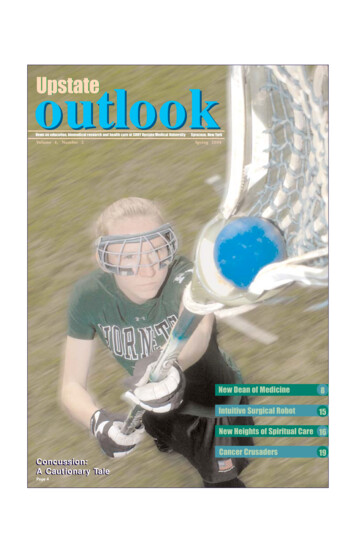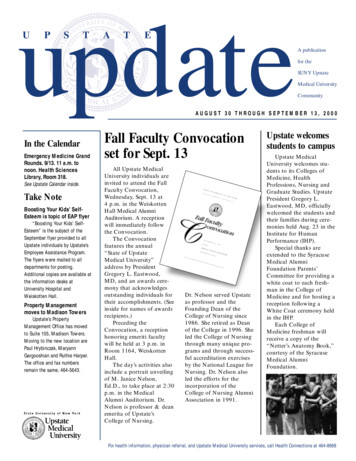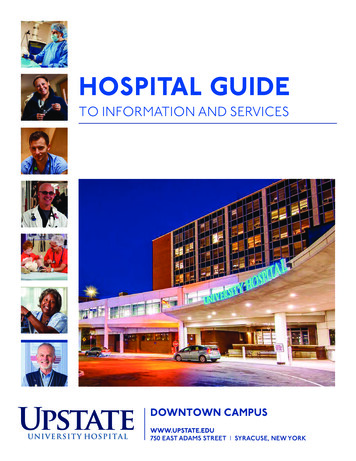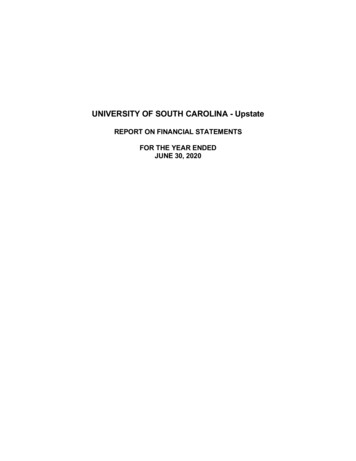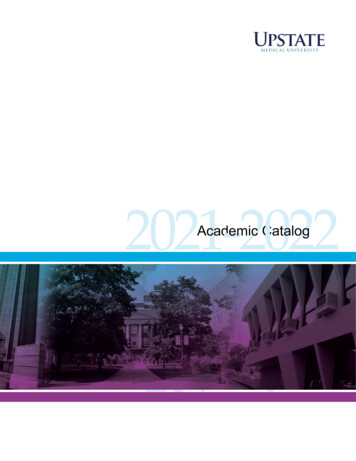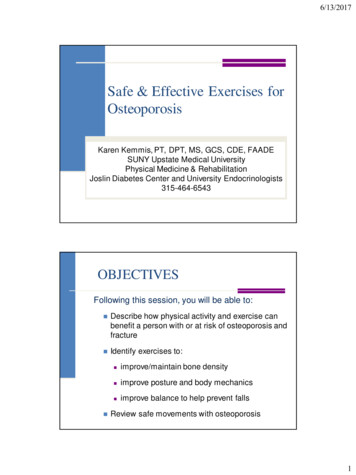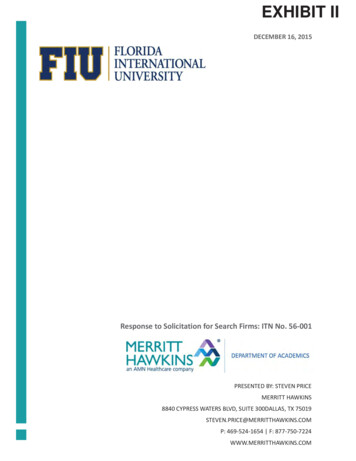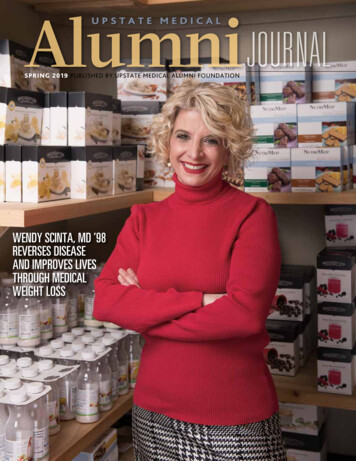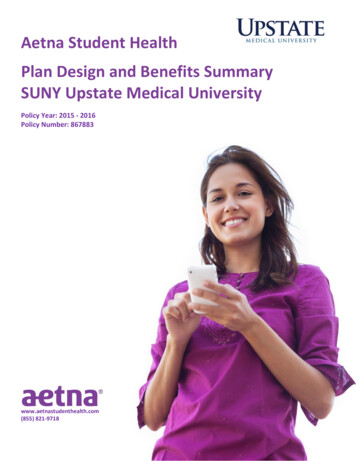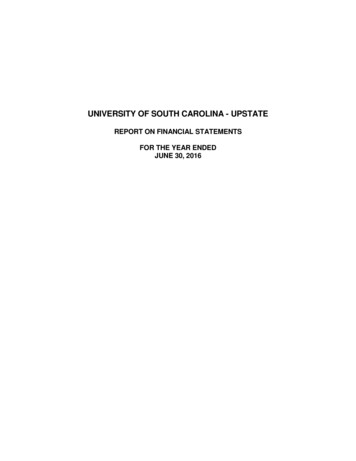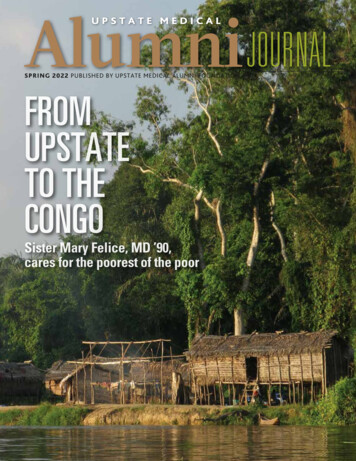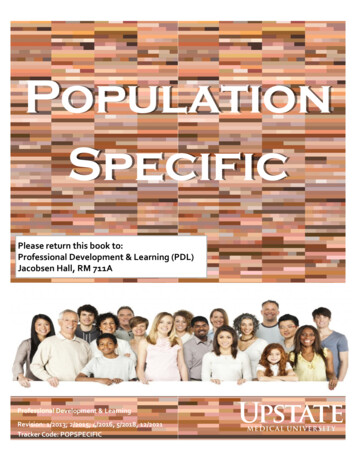
Transcription
PopulationSpecificPlease return this book to:Professional Development & Learning (PDL)Jacobsen Hall, RM 711AProfessional Development & LearningRevision: 1/2013; 2/2015; 4/2016, 5/2018, 12/2021Tracker Code: POPSPECIFIC
INTRODUCTION TO POPULATION SPECIFIC CONSIDERATIONSRATIONALE/OBJECTIVE:Population specific considerations are an important part of patient care. This manual will help you understandone’s physical, psychosocial, cognitive and safety needs at every stage of life. It will also assist with learningspecific interventions within each stage to help provide optimal patient care.The delivery of safe and appropriate care to patients of all ages and is a priority for all health careorganizations. Education, training, and competencies will be implemented and documented per UniversityHospital policy. All staff members are obligated to apply their population-specific knowledge and skills for thewell-being of all patients, families, and visitors.WHO SHOULD COMPLETE THIS SELF-STUDY?All employees who provide direct care to patients or who are non-clinical that have regular patient contactmust take this self-study. For example, Non-clinical employees in Environmental Services or Physical Plant whowork in patient care areas need to complete this self-study. In addition, Clinical employees such as Nurses,Physical Therapists and other care providers need to complete the self-study.CONTENT OF THE SELF-STUDY:This manual is divided into two sections: Clinical and Non-Clinical. There is a separate exam for each section.Both sections of the manual discuss the spectrum of age groups:Age SpecificG R OUPNeonateInfantToddlerPreschoolSchool ageAdolescentYoung adultMiddle adultOlder adultOld, Old adultAge Specific A GER ANGE1 – 4 weeks4 weeks – 1 year1 year – 3 years3 years – 5 years5 years – 12 years13 years – 18 years19 years – 44 years45 years – 65 years65 years – 85 years 85 yearsThe Clinical section of this manual provides more detailed information regarding age specific considerationsfor those employees with a clinical focus.The Non-Clinical section of the manual provides a more general overview of age specific considerations foremployees who interact with but are not directly responsible for hands-on care of patients.HOW TO COMPLETE THIS SELF-STUDY:Read the material in the appropriate section (Clinical or Non-Clinical) of the self-study, complete theappropriate test (Clinical or Non-Clinical) and return the manual, test, and answer sheet to ProfessionalDevelopment & Learning in Room #711A of Jacobsen Hall.ANY QUESTIONS?Please call Professional Development & Learning @ #464-5463.
POPULATION SPECIFIC – TABLE OF CONTENTSSECTION I: CLINICAL EMPLOYEESNeonate . 1Infant . 3Toddler . 5Pre-School . 7School Age . 9Adolescent. 11Young Adult. 13Middle Adult . 15Older Adult . 17Old, Old Adult . 19SECTION II: NON-CLINICAL EMPLOYEESNeonate . 21Infant . 22Toddler . 23Pre-School . 24School Age . 25Adolescent. 26Young Adult. 27Middle Adult . 28Older Adult . 29Old, Old Adult . 30
INSERT TAB DIVIDER HERE:CLINICAL SECTION
Neonate (1 – 4 weeks)Stage of Development: Trust vs. mistrustTrust ability to believe in and rely on othersMistrust may be evidenced as failure to thrivePhysical: Cannot support weight of headAnterior and posterior fontanels not yet closedImmature heat regulationReceding jaundice; umbilical stump healingImmature immune system, still has passive immunity from motherCNS must be stimulated for proper growth and developmentCognitive/Intellectual: Limited: cerebral function not fully establishedBehavior is reflexive in natureLearns through sensory stimulationPsychosocial: Development of trust and is dependent on othersBonding with parents or primary caregiverFears/Stressors: Fears: none evidenced at this timeMajor stressor: physical immaturityOther stressors: lights, noises, handlingSafety: Support head and neck when moving/carrying; protect fontanelMonitor body temperature, maintain environmentWash hands; avoid exposing to infectionsSafe Sleep Environment:o On backo Alone in cribo No loose blankets or pillowsAvoid using “Sleep Positioners”Children under age 1 should always ride in a rear-facing car seat.o Infant-only seats can only be used rear-facingNever leave alone unless in a crib with side rails up and lockedSuspected child abuse, neglect, or unsafe situation must be reportedProfesional Development & Learning (PDL)Revision: 12/2021Tracker code: POPSPECIFICPage 1
General Age Specific Care: Encourage parents to stay close, promote bonding and participation in careLimit the number of caregivers.Swaddling increases feeling of security and comfort.Patient Education: Directed at primary caregiver with emphasis on ADLs, preventive care, immunizations,nutrition, bonding, exposure to infection and safetyAssess parents’ knowledge of and comfort level in caring for the neonateProfesional Development & Learning (PDL)Revision: 12/2021Tracker code: POPSPECIFICPage 2
Infant (4 weeks – 1 year)Stage of Development: Trust vs. MistrustTrust ability to believe in and rely on othersMistrust may be evidenced as failure to thrivePhysical: Obligatory nose breatherPoor temperature control and sensitive to fluid lossImmature immune systemMoves from gross motor to fine motorCan raise head, roll over and bring hand to mouthReflexes diminish and intentional actions beginCan crawl, stand, and even walk alone or with helpCognitive/Intellectual: Learns through sensory stimulation and by imitationLimited ability to communicate needs or problemsRecognizes and differentiates primary caregiver from othersMimics sounds and able to put 2 words together verballyManipulates objects in the environmentPsychosocial: Development of trust and dependent on othersBonding to parents, develops relationships within the family (siblings/grandparents)Begins communication and emotional connection with othersSmiles and repeats actions to elicit response from others (peek-a-boo/pat-a-cake)Fears/Stressors: Major fears: separation from primary caregiver, unfamiliar situations, strangersStressors: loud noises, bright lights, sudden environmental changesParental anxiety may be transmitted to infantSafety: Unable to recognize dangers and should not be left alonePuts objects in mouth - keep small objects and medicines out of reachPlace on back; protect fontanels; prevent heat lossAvoid use of pillows, thick bed clothes or tight clothing/dressings that can constrict thediaphragmProfesional Development & Learning (PDL)Revision: 12/2021Tracker code: POPSPECIFICPage 3
Safety, continued: Protect from falls; side rails always up and safety strap on stroller/highchairChildren under age 1 should always ride in a rear-facing car seat.o Infant-only seats can only be used rear-facingo Convertible and All-in-One car seats have higher height & weight limits for rear-facingpositions, allowing you to keep child rear-facing for a longer period of time.Safe Sleep Environment:o On backo Alone in cribo No loose blankets or pillowsSuspected child abuse, neglect, or unsafe situation must be reportedGeneral Age Specific Care: Encourage parents to stay close; promote bonding and participation in careLimit the number of caregivers in contact with infantMaintain comfortable environment (soft light, warm, noise control)Give familiar objects for comfortPatient Education: Directed at primary caregiverEmphasis on preventive care, immunizations, nutrition, bonding, and safetyProfesional Development & Learning (PDL)Revision: 12/2021Tracker code: POPSPECIFICPage 4
Toddler (1 - 3 years)Stage of Development: Autonomy vs. Shame and DoubtAutonomy self control over motor abilities and body functionsWorks to master the physical environment while maintaining self-esteemPhysical: Has 4– 6 teeth; may continue teething; eats 3 meals/day; feeds with cup and spoon; feedsindependently by 3 years; gains 4–6 lbs/yearWalks by 15 months; runs and climbs by 2 years; stacks blocks, scribbles and enjoys ageappropriate toysNeeds 10-12 hrs of sleep/night plus a daytime napCognitive/Intellectual: Toilet trainingParallel play with othersCan differentiate familiar people from othersLearns through senses, exploration, discovery, and imitationThinking is concrete, literal, and egocentric; short attention span and limited memorycapability; follows simple commandsPsychosocial: Self control and will power, developing sense of independence but remains very dependent onparents for safety, security, and approvalKnows right from wrongIs uninhibited, energetic, seeks attention, positive reinforcement, and approvalImpulsive; moods change quickly; has little self-control over behaviorNeeds the security of routine and is upset by environmental and activity changesFears/Stressors: Major fear: separation from parents/caregivers, may be intenseHospital environment/strangers/procedures may evoke terror responseStressors: loss of control, restriction of movementSafety: Energetic and curious nature may lead to unsafe explorations; accidents may occur asautonomy increasesKeep side rails upChemicals and medications should be kept out of reachChoking on objects is a threatRemain in rear-facing car seat until the top height or weight limit allowed by car seat’smanufacturer.Profesional Development & Learning (PDL)Revision: 12/2021Tracker code: POPSPECIFICPage 5
Safety, continued: Suspected child abuse, neglect, or unsafe situation must be reportedGeneral Age Specific Care: Encourage parental presence and participation with carePrepare child for procedures; use distraction techniques and Child Life ServicesOffer choices when ones existWhen hospitalized, may have difficulty sleeping or nightmaresSpeak at eye level with the child and maintain eye contactPatient Education: Directed at primary caregiver and child immediately before proceduresGive toddler brief, simple and concrete explanations in words they can understand; give onedirection at a time; use of play to facilitate learning and to anxiety(dolls/puppets/storybooks)Profesional Development & Learning (PDL)Revision: 12/2021Tracker code: POPSPECIFICPage 6
Pre-School (3 - 5 years)Stage of Development: Initiative vs. GuiltInitiative tasks include exploring, seeking answers, distinguishing between sexesNeeds balance between needs for exploration and necessary limits on behaviorPhysical: Should grow 4-5 lbs and 2 - 3 inches per yearAll primary teeth should be present and eats three meals a dayNeuromuscular, gross and fine motor skills refined (i.e. balance improved, greater muscularstrength, jumps in place, walk on tip toes, stands on one foot and hops, draws/copies a circle)Able to feed and dress selfBowel/bladder patterns establishedCognitive/Intellectual: The “why” stage: wants to know the cause and purpose of everythingUnable to think abstractly; still concrete, literal, magical, and egocentric thinkers with difficultydifferentiating reality from fantasyShort attention spanOriented to the present only – unable to comprehend anticipatory explanationsPsychosocial: Able to tolerate brief separation from parents when explanation givenEgocentric, but is increasingly aware of self vs. othersBeginning to identify gender typical rolesLearning to play in groups; imitates adultsHome rituals/habits are importantLikes to pretend; ascribes living qualities to inanimate objectsNeeds praise/encouragement; feels guilty if disappoints parents/makes mistakesFears/Stressors: Fear of the unknown, of the dark, of mutilation, bodily injury, or being left aloneStress and illness may cause regression and separation anxietySafety: Needs constant supervisionAccidents and injuries remain a threat due to curiosity and exploration; keep medications andsmall objects out of reachForward-facing car seat with harness until they reach top height or weight limit via car seatmanufacturer. Once child outgrows car seat, travel in booster seat, but still in the back seat.Suspected child abuse, neglect, or unsafe situation must be reportedProfesional Development & Learning (PDL)Revision: 12/2021Tracker code: POPSPECIFICPage 7
General Age Specific Care: Encourage parental presence and participation with care as much as possible while in hospitalsettingPrepare child for procedures within 5 minutes of procedure; use distraction techniques; praiseand rewards after proceduresUtilize Child Life services to assist in explanation of procedures, equipment and to offerdistraction.Offer choices when ones existWhen hospitalized, may have difficulty sleeping or nightmaresPatient Education: Directed at primary caregiver and preschoolerPreschooler is very interested in knowing why things are being done to them - answerquestions quickly, honestly, using concrete words they understand, not abstract statements;use of dolls/puppets/storybooks to facilitate learning and decrease anxiety; honesty isespecially importantProfesional Development & Learning (PDL)Revision: 12/2021Tracker code: POPSPECIFICPage 8
School Age (5 - 12 years)Stage of Development: Industry vs. InferiorityIndustry interest in developing a sense of self through engaging in tasks and refiningskills/doing work; task mastery involves self-confidence, perseverance, self-control,cooperation, recognitionInferiority feelings of inadequacy and fearsPhysical: Seasonal growth spurts in Spring and Fall; should gain 5-6 pounds per year; some clumsinessmay occur as a result of growth spurtsBaby teeth replaced with permanent teethIncreased muscle mass and strength; neuromuscular skills and balance improvedDespite wide variations, early signs of puberty may appearCognitive/Intellectual: Increased comprehension; thinking is concrete, literal, and specific; logical and more deductivereasoning begins; understands cause and effect; solves problemsFunctions in present; begins understanding the past and can foresee future consequences;tells time and plans aheadIncreased understanding of death and it’s finalityMay be reluctant to ask questions or admit they don’t understandPsychosocial: Same-sex peers more important than family; influenced by non-parent adult idolsLearns gender typical behavior, attitudes, and rolesRules are important to themBehavior controlled by expectations, regulations, anticipation of praise or blame; beginsquestioning parental authority; needs praise/encouragement from adultsWants control over privacyFears/Stressors: Great fear of the unknown, pain, bodily injury, mutilation,separation from caregivers and friends, death, loss of control,failure to live up to expectations or disappointing significantothersResents forced dependence and lack of privacyViews illness/pain with guilt and/or as punishmentProfesional Development & Learning (PDL)Revision: 12/2021Tracker code: POPSPECIFICPage 9
Safety: Peer pressure may influence child to act with poor judgment; takes risks/daresSafety helmets for biking/skateboarding; seat belts will replace car/booster seatsIndependent behavior may cause ingestion or overdose of available medicationsKeep in a booster seat until they are big enough to fit in a seat belt lies snugly across theupper thighs, not the stomach. Shoulder strap should lie snug across the shoulder & chest,not across the neck or face.Suspected child abuse, neglect, or unsafe situation must be reportedGeneral Age Specific Care: Encourage parental presence and participation with care as much as possiblePrepare child for procedures ahead of time.Allow participation in discussions/decision making and expression of feelings and fears.Provide privacyDefine and reinforce behavior limits; offer choices when ones existContinue schoolingPatient Education: Directed at primary caregiver and/or school age childExplain procedures in advance with correct terminology in simple termsDetailed information enhances the child’s sense of control and independenceProfesional Development & Learning (PDL)Revision: 12/2021Tracker code: POPSPECIFICPage 10
Adolescent (13 - 18 years)Stage of Development: Identity Formation vs. Identity/role confusionIdentity Formation need to establish a stable sense of self, who they are, where they fit in,where they are goingTasks include: independence from parents to establish their role in society; establishingrelationships with members of opposite sex; coping with body changes; development of sexualidentity and self-conceptPhysical: Adult weight achievedRapid changes in terms of height and sexual characteristicsMay need more rest and sleep due to rapid growthPermanent teeth; increased body hair and blemishesCognitive/Intellectual: Increased abilities for logical, abstract, deductive thought,and analytical reasoning; understands hypothetical situations; forms own opinionsLimited understanding of body structures and functionsGains introspectionSelf esteem grows internallyDevelopment of occupational identityDoesn’t like to ask questions which make them appear “stupid”Psychosocial: Concerned about how they appear to othersDevelops sexual identity; relationships with opposite sex take on new meaning; peer groupimportant; interest in slang words particular to peer groupOften question or rebel against authority figures and may criticize parentsNeeds time to adjust and cope with events; may need (but not request) adult support to copeeffectivelyUnaware of own mortality; feel invincible and that nothing will happen to themFears/Stressors: Major concerns: appearance, school performance, loss of control, separation or lack ofacceptance from peers, being differentPhysical changes associated with illness or injury may be threateningProfesional Development & Learning (PDL)Revision: 12/2021Tracker code: POPSPECIFICPage 11
Safety: Peer pressure may influence to act with poor judgment; takes risks/daresUse of automobiles; risk of accidents increases for self and othersSuicide is third-highest cause of death; Sexually Transmitted Diseases (STDs) and depressionis at a high levelMay experiment with drugs, cigarettes, alcohol, and sexual activityAny suspected abuse, neglect, or unsafe situation must be reportedGeneral Age Specific Care: Involve adolescent in care with participation in decision making; needs control over eventsinvolving them; choice whether parent is presentDefine and set limits firmly when necessary; offer choices when ones existRespect privacy and opinions; interview directly; may need to separate from parentContinue schoolingPatient Education: Inquire if they want parents present during teaching sessionsUse patient’s preferred method of education (visual, auditory, etc.); give scientific explanationsusing body diagrams, models or videotapesEncourage questions and verbalization of feelingsProvide education about cigarettes, alcohol, drugs, and STDsProfesional Development & Learning (PDL)Revision: 12/2021Tracker code: POPSPECIFICPage 12
Young Adult (19 - 44 years)Stage of Development: Intimacy vs. IsolationIntimacy reaching out and using one’s self to form a commitment to an intense, lastingrelationship with another personIsolation manifested with poor self-esteem and withdrawalPhysical: Biological maturity is completeBrain cell development peaksWomen see most significant changes during pregnancy and lactationCognitive/Intellectual: Wide range of life experiences assist in developing adult intellectual capacitiesReaches peak intelligence, memory, and abstract thoughtForms their own opinions and makes independent decisionsChooses vocation; receives appropriate educationPsychosocial: Resolving issues from adolescence; establish personal identity, values, attitudes, interests, andacceptance of selfDevelop adult roles and responsibilities at work, home, and societyComes to terms with sexuality and preferencesDevelops and maintains friendships and intimate love relationshipFears/Stressors: Loss of independence; loss of job due to illness/injurySeparation from spouse/significant others, children, and friendsBalancing roles of career, marriage, and child-rearing simultaneouslyChallenges: managing growing number of responsibilities at home, work, school, orcommunitySafety: Major cause of death related to accidents, suicide, and homicidesSeat belt use in automobilesStress and depression may be experiencedSTD is a risk due to experimentation with various lifestyles; encourage condomsPromote recreational and personal safety habitsSuspected domestic violence, abuse, or unsafe situations must be reportedProfesional Development & Learning (PDL)Revision: 12/2021Tracker code: POPSPECIFICPage 13
General Age Specific Care: Should receive at least one thorough health assessment yearly (screen for STDs, hypertension,and cholesterol levels); smoking cessation counseling/program if applicableTreat with respect; encourage decision-making and self-careDon’t be judgmental; support decisions you may not makeInvolve the individual with plan of care and decision making.Explore the impact of hospitalization or illness on work, job, family and other commitments.Encourage visits from significant othersNever use terms of endearment (honey, sweetie, darlin’)Patient Education: Include significant other in educationUse patient’s preferred method of education (visual, auditory, etc.)Profesional Development & Learning (PDL)Revision: 12/2021Tracker code: POPSPECIFICPage 14
Middle Adult (45 - 65 years)Stage of Development: Generativity vs. StagnationGenerativity concern about providing for others that is equal to concern about providing foroneself; guiding the next generation; contributing to humanityStagnation self-absorptionPhysical: Slowing of physiologic functions and possibility of chronic health issues height, muscle mass/tone/subcutaneous fat, near vision (presbyopia), nerve conduction,ability to hear high-pitched sounds; skin begins to dryInability for tissue regenerationDecreased bone density and strengthAtrophy of reproductive system; hormone production decreases; menopauseCognitive/Intellectual: Time of maximum command of self and influence over othersForms own opinions; makes numerous decisions; may hold highest status jobLife experiences provide continued learning; reflects on and reassesses lifeUnderstands reality of deathPsychosocial: “Sandwich generation” – concurrent responsibilities for children and aging parents (especiallyfor women)o Maintaining contact with, but letting go of parental authority over, childreno Meeting needs of aging parentso Additional supports may be neededAchieving financial and emotional securityFinding new sources of satisfactionPreparing for retirementFears/Stressors: Loss of control and values important to the family; dependency on othersLoss of youth, vitality, sexual appealWork and social status; disenchantment with workHeavy financial responsibilities; makes major life decisionsBalancing roles and responsibilities of career, family, and friendsLoneliness as children leave home; caregiver role for elderly parentsMenopause for womenDeath; death of spouseProfesional Development & Learning (PDL)Revision: 12/2021Tracker code: POPSPECIFICPage 15
Safety: Risk for heart attack, stroke, and fracturesSuspected domestic violence, abuse, or unsafe situations must be reportedGeneral Age Specific Care: Respect their decisions; allow as much control over their care as possibleNever use terms of endearment (honey, sweetie, darlin’)Allow verbalization of fears and concernsNeed regular physicals and health care screeningsInvolving the significant other with plan of careProvide privacyProvide for mobility and functional needsPatient Education: Include significant other and family in educationUse patient’s preferred method of education (visual, auditory, etc.)Cardiovascular health; weight bearing exercisesProfesional Development & Learning (PDL)Revision: 12/2021Tracker code: POPSPECIFICPage 16
Older Adult (65 – 85 years)Stage of Development: Ego Integrity vs. DespairEgo Integrity accepts life and self as they areDespair remorse about what could have beenPhysical: Diminished function; muscle atrophy; brittle bones; stiff joints; fragile/dry skinCardiovascular: cardiac force, cardiac output, and arterial elasticityLungs more rigid, oxygen exchangeLoss of teeth ability to fight infection sensory function and balanceSleep pattern irregularityCognitive/Intellectual: Performs cognitive tasks more slowly due to:o visual, auditory, and tactile acuityo slower motor responses to sensory stimulio short term memory lossesNeeds time to process information and link eventsIntellectual ability tends to decline depending on usePsychosocial: Coping with adjustments necessitated by advanced age, illness, disabilityReviews life’s accomplishments and deals with lossConfronts their own mortality and death of spouse, friends, and associatesFears/Stressors: Loss or death of spouse, adult children, and friendsDeclining mental and physical health; social isolationDiminished self-relevance of values important to familyLoss of independence or increased dependency on othersSafety: injury risks due to physical and cognitive impairments; may be unable to recognize dangers;increased risk for fallsUnfamiliar environment and presence of strangers may cause confusion and/or agitation andfallsSuspected elder abuse, neglect, or unsafe situations must be reportedProfesional Development & Learning (PDL)Revision: 12/2021Tracker code: POPSPECIFICPage 17
General Age Specific Care: Preserve dignity and autonomy as much as possibleInvolve family with plan of careEncourage reminiscence and validating concerns.May require re-orientation to environment, time, and dayInjury prevention precautions (fall prevention, skin integrity maintenance)May require increased use of assistive devices (canes, walkers, wheelchairs)Never use terms of endearment (honey, sweetie, darlin’)Provide adequate lighting and ensure adequate warmth due to heat regulationPatient Education: May require longer time to learn; ensure use of communication aids (hearing aid, eyeglasses)Face patient and speak slowly and distinctly; do not shoutInclude significant other/family members in education and decision makingAllow verbalization of fears and concernsProfesional Development & Learning (PDL)Revision: 12/2021Tracker code: POPSPECIFICPage 18
The Old-Old Adult (85 or more years)– Fastest growing segment of the populationStage of Development: Ego Integrity vs. DespairEgo Integrity accepts life and self as they areDespair remorse about what could have beenPhysical: Diminished function; muscle atrophy; brittle bones; stiff joints; fragile/dry skinCardiovascular: cardiac force, cardiac output, and arterial elasticityLungs more rigid, oxygen exchangeLoss of teeth ability to fight infection sensory function and balanceSleep pattern irregularityCognitive/Intellectual: Performs cognitive tasks more slowly due to:o visual, auditory, and tactile acuityo slower motor responses to sensory stimulio short term memory lossesNeeds time to process information and link eventsIntellectual ability tends to decline depending on usePsychosocial: Coping with adjustments necessitated by advanced age, illness, disabilityReviews life’s accomplishments and deals with lossConfronts their own mortality and death of spouse, friends, and associatesFears/Stressors: Loss or death of spouse, adult children, and friendsDeclining mental and physical health; social isolationDiminished self-relevance of values important to familyLoss of independence or increased dependency on othersProfesional Development & Learning (PDL)Revision: 12/2021Tracker code: POPSPECIFICPage 19
Safety:
INTRODUCTION TO POPULATION SPECIFIC CONSIDERATIONS. R. ATIONALE /O. BJECTIVE: Population specific considerations are an important part of patient care. This manual will help you understand one's physical, psychosocial, cognitive and safety needs at every stage of life.
